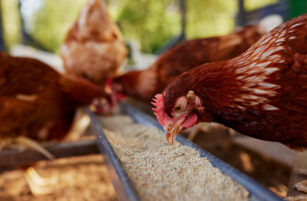Insight Focus
- Appetite for US corn is waning as price points remain too high compared to regional competitors.
- The weather is presenting issues for both corn and wheat as it threatens to slow planting and harvesting.
- The situation in the Black Sea seems to be stabilizing as the new grains corridor begins operating.
Forecast
There is no change to the forecast for Chicago corn. Prices will continue to follow the USD 3.90/bushel to USD 4.15/bushel range for the average of the 2023/24 crop (September – August). The average price since Sept. 1 is running at USD 4.82/bushel.
High Corn Supply in US Contrasts with Lower EU Yields
Corn is starting to feel the harvest pressure with both the futures and the basis down to close the week negative. The line up out of the Black Sea continues to increase.

Corn in Chicago started the week negatively with a lower-than-expected number of export inspections. According to USDA data, just 437,549 tonnes of corn were inspected for export for the week ending 19 October, down 6.2% on the week and 7.4% on the same week of 2022. This makes sense given the high corn price FOB Gulf compared with other origins, particularly Brazil.
In Europe, the October MARS bulletin reduced corn yields to 7.13 tonnes/hectare or 2% lower than the previous estimate. This is mostly due to dryness in southeastern Europe. Low rainfall across swathes of Bulgaria, Hungary, Romania and Greece along with unusually high temperatures were cited for the revision.
However, the European Commission maintained its corn production forecast at 59.9 million tonnes, a 13% year over year increase.
Strong progress on the pace of the harvest has weighed further on prices. US corn is 59% harvested, about level with the same period of last year but five percentage points above the five-year average. Drought conditions improved with 49% of corn impacted this week compared with 50% last week. In Brazil, the first corn crop is slightly behind with 33% planted vs. 35,8% last year.
Russian corn is 47% harvested and Ukrainian Corn is 48% harvested. French Corn is 85% harvested, behind the 96% recorded at the same point last year. The condition of the crop is favourable, with 83% assessed as being “good to excellent” condition.
Ukraine Wheat Corridor Functioning Well
Wheat also started the week negative in Chicago. Just like in the corn market, this was mainly due to other origins being cheaper — particularly the Black Sea. Rains in the US wheat region also pushed the market lower on the expectation of a healthy start to the wheat season.

The European Commission marginally increased its wheat production forecast by 200,000 tonnes to 125.5 million tonnes, an event that was virtually immaterial to the market. French wheat is slightly behind last year though at 54% planted compared with 61% in the same period of 2022.
Russian spring wheat is 96.5% harvested and Planting in Ukraine is 79,4% complete. The Russian Ministry of Agriculture confirmed the consensus of the market of a 90 million tonne wheat crop.
The queue of vessels in the Black Sea continues to increase as new cargoes arrive and complicated logistics and weather cause the flow to slow down. As many as 80 vessels appear to be in the lineup. There were some fears last week that Russia could block the trade flow, but Ukraine said the corridor continues to work properly and more vessels arrived for loading. Conditions in the Black Sea appear to be easing.
US winter wheat is now 77% planted, about on par with last year and the five-year average. We could see some price support this week in Chicago if rain slows down the corn harvesting and wheat planting pace. But overall, the risk should be to the downside as new crop corn starts to hit the market and stocks start to pile up.
Rains are expected everywhere this week starting with Brazil and Argentina, followed by the US Corn Belt and wheat growing areas, and finally they will hit Europe.














